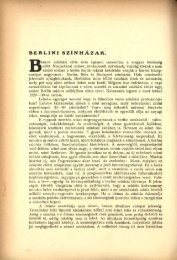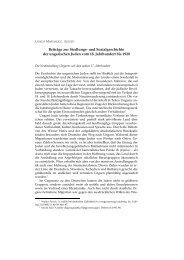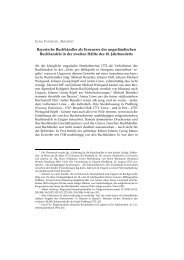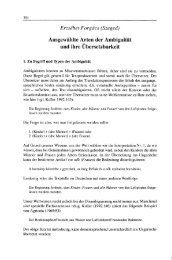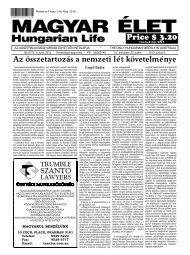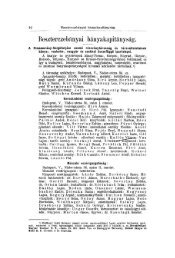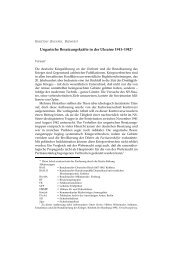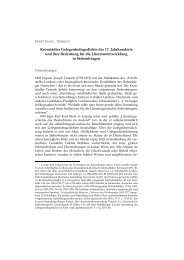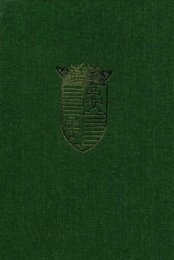Osservatorio letterario ANNO 14. – NN. 73/74 MARZ.-APR./MAGG ...
Osservatorio letterario ANNO 14. – NN. 73/74 MARZ.-APR./MAGG ...
Osservatorio letterario ANNO 14. – NN. 73/74 MARZ.-APR./MAGG ...
Create successful ePaper yourself
Turn your PDF publications into a flip-book with our unique Google optimized e-Paper software.
with ethnic problems (problems of ethnogenesis)<br />
professionally and purposefully.<br />
According to the majority of the opinions, the<br />
ancient Magyars departed from their “genetic nest”,<br />
and left those Eastern peoples of which they derived<br />
from, at about the second half of the 9 th Century. The<br />
problem of the original home of the Magyars in the East<br />
has been disputed already for many years, beginning<br />
from the second half of the 19 th Century. Many<br />
hypotheses, points of view appeared and continue to<br />
appear in the circle of researchers. It is beyond the<br />
limit of our article to tell all about them. Special<br />
research would be needed, which deals only with this<br />
problem. It is good news that such researches have<br />
begun just in the circle of Hungarian researchers lately<br />
(See for example, G. Gyóni, 2007). One thing is clear:<br />
there isn’t any doubt that the Land-conquering Magyars<br />
arrived from the East into the Carpathian Basin.<br />
Constantine Porphyrogenetos, the author of the famous<br />
work: “On ruling and directing the Empire” was the first<br />
who gave information about the appearance of the<br />
Magyars in East-Europe. The Byzantine Emperor named<br />
the Magyars by the ethnic term “Turks”. However, he<br />
remarks that earlier their name was “savarto-asphaloi”<br />
(Savirs, Sabirs, Sabars). In the course of a war against<br />
the Pechenegs, the Magyars separated into two parts:<br />
to Eastern and Western Magyars. The Eastern Magyars<br />
kept their name, the “savarto-asphaloi” [Constantine<br />
Porphyrogenetos, 1991, p. 159<strong>–</strong>161]. It is most<br />
probable that the Byzantine author not only distorted<br />
the denomination of the Magyars, but interpreted it<br />
improperly as well. However, there is very important<br />
information here: the Eastern part of the Magyars<br />
remained somewhere in the East. The events<br />
connected with the separation of the once integrated<br />
Magyar nation happened not on the East-European<br />
steppes situated North of the Black Sea, but<br />
somewhere deeper in the East. It is possible that the<br />
process of the separation took longer time, than it is<br />
accepted by most of the researchers. Maybe, it had<br />
began already between the Volga and Ural rivers, and<br />
continued for some decades. A branch of the Magyars<br />
departed for the West. In the course of their<br />
wanderings these Magyars got further and further from<br />
their Eastern brethren, and kept contact with them less<br />
and less. There is no kind of doubt that the existence of<br />
the Eastern Magyars between the Volga and the Ural<br />
Mountains was historical fact. In the 11-13 th Centuries<br />
the Arabic and Persian authors give information both<br />
about the Eastern and Western Magyars. (“Maggari”,<br />
al-Maggariya”, “bilad Basgird wa Magar”, as selfdenomination<br />
of the people and the country; “al-Magar”<br />
<strong>–</strong> the name of the medieval town in the Northern<br />
Caucasus).<br />
The Eastern Magyar people and her country<br />
existed most probably independently in the Volga-Ural<br />
Region, in the south-east direction from the Volga-<br />
Bulgarian state, until the Mongolian conquest. However,<br />
it is difficult to say, whether they had a state really in<br />
the given period. The author of the “Secret History of<br />
the Mongols” (1240). tells just about their state in the §<br />
262 of the book. This paragraph tells about those<br />
events when Subetei-Bagatur had directed his army<br />
into western direction (in the text: in northern<br />
direction), and subjected 11 nations and countries:<br />
“Kanlin, Kibcsaut, Bachžigit, Orosut, Machžarat, Asut,<br />
Sasut, Serkesut, Keshimir, Bolar, Raral (Lalat)”. The<br />
Mongolian army had to cross rivers abundant in water:<br />
the Idil and the Ajakh (the Volga and the Ural Rivers).<br />
One can see clearly from this report that the Mongol<br />
name of the country of the Eastern Magyars was<br />
“Machžarat” (the Machžar etnonym with the “at” ending<br />
in plural number). So, here the information tells just<br />
about the Eastern Magyar people and country.<br />
According to some long-living theories, Pannonia<br />
(Transdanubia, Hungary) was understood under this<br />
country-name. However it was beyond the task of that<br />
Mongolian army which appeared in the Volga-Ural<br />
Region between1229<strong>–</strong>1232, to conquer the Hungarian<br />
Kingdom. Besides others, the Carpathian basin was<br />
very far from the Volga-region. The primary task of<br />
Subetei’s army was to subjugate the local people there<br />
<strong>–</strong> the Kipchaks, Bulgarians, Magyars, Saksins, Bashkirs,<br />
etc. Another paragraph of this valuable written source<br />
tells about the hard fights of the Mongolian army with<br />
these countries: “(As) Subetei-Bagatur met hard<br />
resistance from the part of those countries and towns<br />
which had to be conquered by him, especially from the<br />
part of “Kanlin, Kibcsaut. Bachžigit, Orosut, Asut, Sesut,<br />
Machžar, etc” [Kozin 1941, § 262, 270]. We must not<br />
be embarrassed by the fact that Western territories, far<br />
from the Volga-river are (for example Kiev) are also<br />
mentioned in these texts of the “Secret History”. This<br />
work is written in artistic, heroic style, and wants to tell<br />
about all feats of the Mongols. That’s why it mentions<br />
all conquered nations in one context. The text quoted<br />
above confirms the information noted in the work of<br />
Abu-L-Gazi about the conquest “of the territories of the<br />
Madžars and Bashkurds” [Abu-L-Gazi 1996, p. 99,<br />
103].<br />
We also get information about the hard<br />
resistance of the Magyars against the Mongols from<br />
Brother Julian. This Hungarian monk of the Dominican<br />
order visited the territory where the Eastern Magyars<br />
were living between the years 1235<strong>–</strong>1238 twice.<br />
Brother Julian was sent to the East exactly with the<br />
task of finding the Eastern Magyars, the relatives of<br />
that people which was living in the Hungarian Kingdom<br />
in the Carpathian Basin. This self-sacrificing man lacked<br />
needs and suffered from fame and thirst in the course<br />
of his long travel, buried all those who accompanied<br />
him, but finally he found those whom he wanted to find<br />
so desperately. He met a Magyar woman in one of the<br />
towns of Volgan Bulgaria. This country had been<br />
situated in eastern or south-eastern direction from the<br />
country of the Eastern Magyars. The woman showed<br />
Brother Julian the way into her original homeland. We<br />
can read the followings in the given written source: “In<br />
one of the large towns of that region, which was<br />
defended by fifty thousand soldiers, the monk found a<br />
Magyar woman, who was married off into Bulgaria from<br />
that country which had been searched by Brother<br />
Julian. She showed the monk the way to her homeland,<br />
and added that he can find those whom he is looking<br />
for, after a two days’ travel. It really happened so. He<br />
found them close to the Large Atil-River.” [Anninskij,<br />
1940, p. 82.]. So, the text of the report informs us that<br />
Brother Julian did not have to take a long way already<br />
112<br />
OSSERVATORIO LETTERARIO Ferrara e l’Altrove <strong>A<strong>NN</strong>O</strong> XIV <strong>–</strong> <strong>NN</strong>. <strong>73</strong>/<strong>74</strong> <strong>MARZ</strong>.-<strong>APR</strong>./<strong>MAGG</strong>.-GIU. 2010


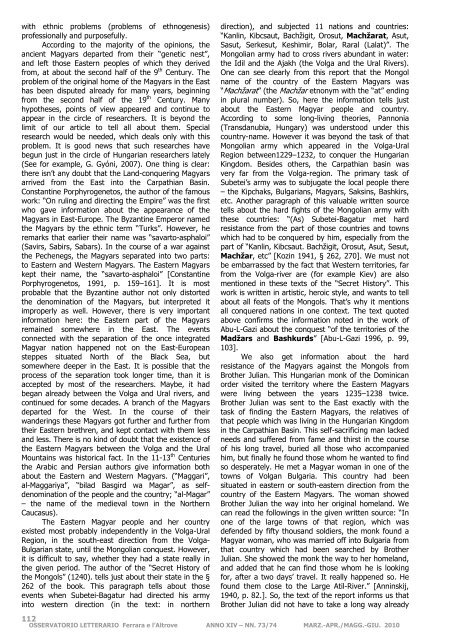
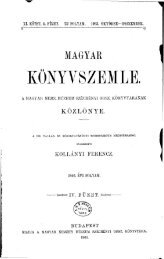
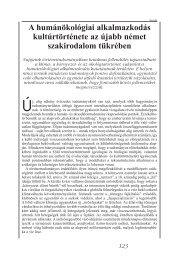
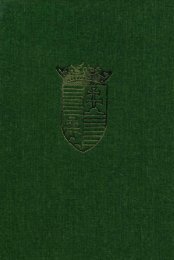
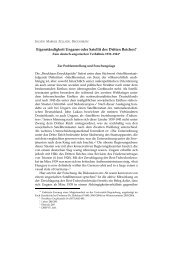
![Letöltés egy fájlban [36.8 MB - PDF] - EPA](https://img.yumpu.com/23369116/1/172x260/letoltes-egy-fajlban-368-mb-pdf-epa.jpg?quality=85)
